Art Fairs
Frieze Los Angeles Opens With Pop-Cultural Cachet in the Aisles, on the Stands, and in the Sales Figures
The fair debuted with an impressive slate of sales, including several works that spoke directly to a hoped-for Hollywood clientele.
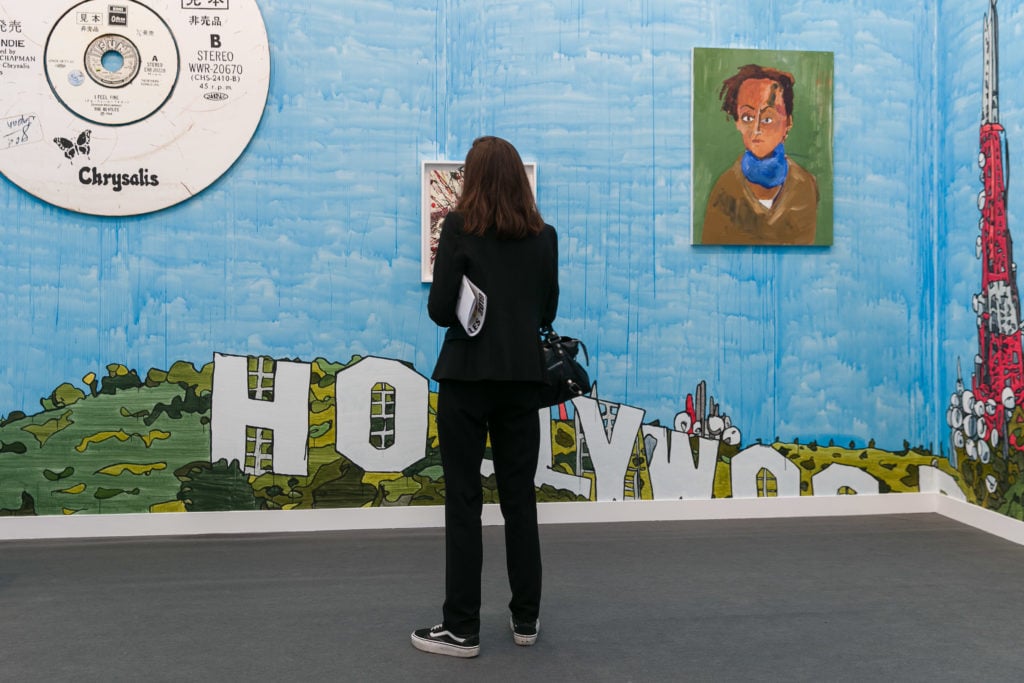
The fair debuted with an impressive slate of sales, including several works that spoke directly to a hoped-for Hollywood clientele.

As members of the press would be the first to admit, it has been nearly impossible to discuss the inaugural edition of Frieze Los Angeles without positioning it as a possible inflection point in the city’s public perception. Although Los Angeles has been a bastion of important institutions for decades and important artists even further back, it is still viewed first and foremost as the seat of the entertainment industry (and for good reason). Frieze Los Angeles hopes to cue the masses to understand the city as a fully formed cultural destination, not just a pop cultural one.
Yet the contemporary art world—and, more pointedly, the contemporary art market—understands that it can only flourish in LA with Hollywood’s buy-in, in both the literal and figurative senses. So it’s no surprise that, on day one of the fair several booths incorporated works that explicitly nodded to pop culture, celebrity, and mass-market art forms like film and music. And while those works ultimately only made up a small minority of the available offerings, their inclusion helped pave the way to a strong opening day of trading on Thursday, February 14, at the fair’s debut incarnation.
The scene on the ground reflected plenty of enthusiasm. The early afternoon saw the main fair’s tent packed with art-world regulars highlighted by the likes of Los Angeles County Museum of Art director Michael Govan, Dallas mega-collectors Howard and Cindy Rachofsky, and Art Agency, Partners’ Allan Schwartzman, while silver-screen stars Brad Pitt, Jodie Foster, and Sylvester Stallone could all be seen touring the aisles throughout the day.
Still, the biggest early sales activity had more to do with art stardom than mass-media stardom. Hauser & Wirth thundered out of the gate just after noon to announce it had placed Mike Kelly’s environmental installation Unisex Love Nest with a private European foundation at a price of $1.8 million. A few hours later, Lévy Gorvy broadcast a pair of seven-figure sales: Yayoi Kusama’s Infinity Nets (B-A-Y) for $1.6 million and Günther Uecker’s Spirale III for $1.2 million.
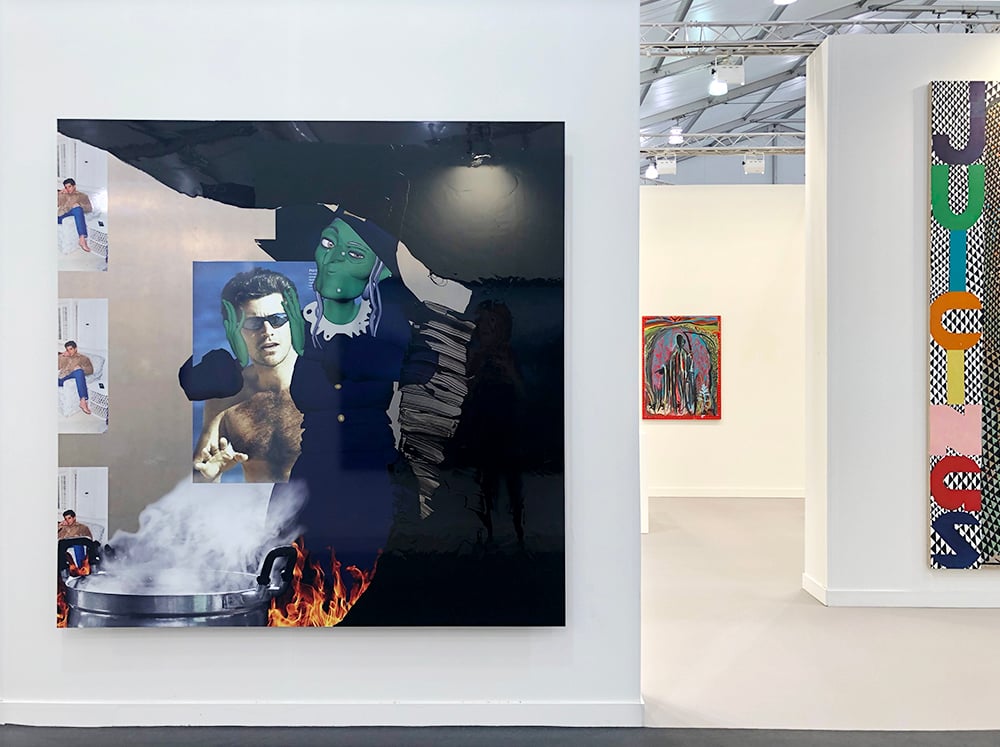
Jordan Wolfson, Untitled, at David Zwirner’s stand at Frieze Los Angeles. Image courtesy of David Zwirner.
But other heavy-hitting galleries leaned into the power of celebrity, whether intentionally or by happenstance. An outside wall of David Zwirner’s stand hosted Jordan Wolfson’s Untitled, a UV print with enamel on aluminum featuring multiple images of late Camelot heir, publishing magnate, and tabloid heartthrob John F. Kennedy, Jr. However, Zwirner director Branwen Jones credited Wolfson as the driving force for the piece’s inclusion at Frieze Los Angeles, where the gallery sought to present a compelling cross-section of its program rather than set a thirst trap for new Hollywood clients. “Jordan doesn’t make that much work, and we never ask for specific things,” she explained. “We trust what our artists give us.” The piece sold for an undisclosed amount by mid-afternoon. A client also reserved Raymond Pettibon’s small portrait sketch Untitled (Anthony Bourdain), part of a salon-style hang on an adjoining wall of Zwirner’s booth, the same day.
A subtler entrée to the entertainment world appeared inside Jack Shainman’s booth nearby: Carrie Mae Weems’s The Blues, a set of 25 azure-toned pigment prints featuring R&B royalty and actress Mary J. Blige. The gallery placed one edition of the piece with an out-of-town buyer for $110,000 early in the fair, according to senior director Tamsen Greene, though other editions were still available.
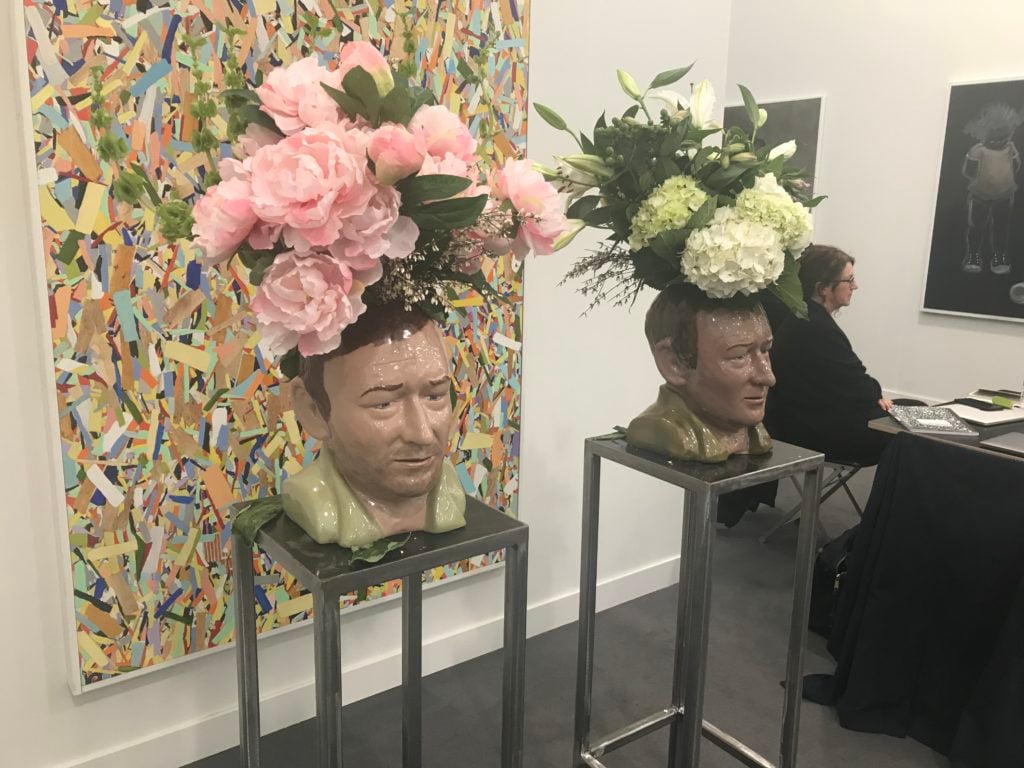
Kim Dingle, Duke Jar #1 and Dukejar #2, both 1991, at Susanne Vielmetter’s booth at Frieze Los Angeles. Photo by Tim Schneider.
Other Hollywood-inspired pieces drew interest but didn’t yet require invoicing by publication time. Out front at Los Angeles mainstay Susanne Vielmetter’s booth were Kim Dingle’s Dukejar #1 and Dukejar #2, ceramic cookie jars doubling as busts of John Wayne. (For Valentine’s Day, the gallery converted the cookie jars to flower vases.) Dingle requested that the works, priced at $18,000 each, be included on the stand in part because of the Duke’s history at Paramount, where he shot nine movies during his illustrious career. Although the sculptures had not sold by mid-afternoon, “several” of the artist’s more confrontational recent paintings found buyers for $22,000 each, according to gallery associate Elsa Bruno. The largest painting, a dark and stormy vision of cartoon-inflected violence priced at $70,000, was still available at press time.
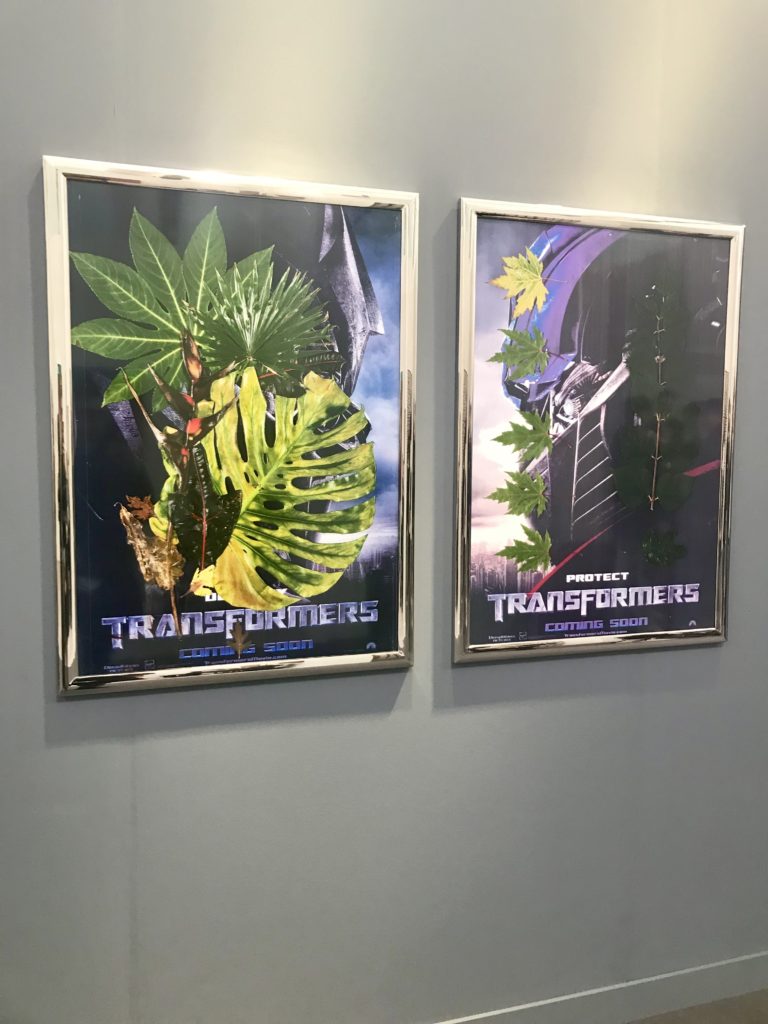
Timur Si-Qin, Untitled and Untitled, both 2011, at Société’s booth at Frieze Los Angeles. Photo by Tim Schneider.
Berlin gallery Société included two works with direct but less human Hollywood cachet. Installed on the stand’s exterior wall were two untitled prints by Timur Si-Qin from 2011, each featuring an image of a promotional poster for Michael Bay’s original Transformers blockbuster overlaid with plant imagery. (Coincidentally or not, Paramount handled the movie’s international distribution.) Similar to the professed thinking at David Zwirner, owner Daniel Wichelhaus said the works were chosen to give Los Angeles, a market where the gallery has not been very active to date, a rigorous sampling of its program. Regardless of the motivation, the same collector placed both works on hold by late afternoon.
But the most enigmatic celebrity nod of all could be found occupying pride of place in the booth of New York’s Greene Naftali. Rachel Harrison’s 2018 Sculpture with Hot Sauce consisted of a craggy burgundy mass atop a wooden side table. Draped over the rock-like formation was a white leather purse with gold accents by Y2K-era streetwear brand Baby Phat. Jutting out from inside were brick-like forms wrapped in foil and a titular bottle of Cholula Chipotle.
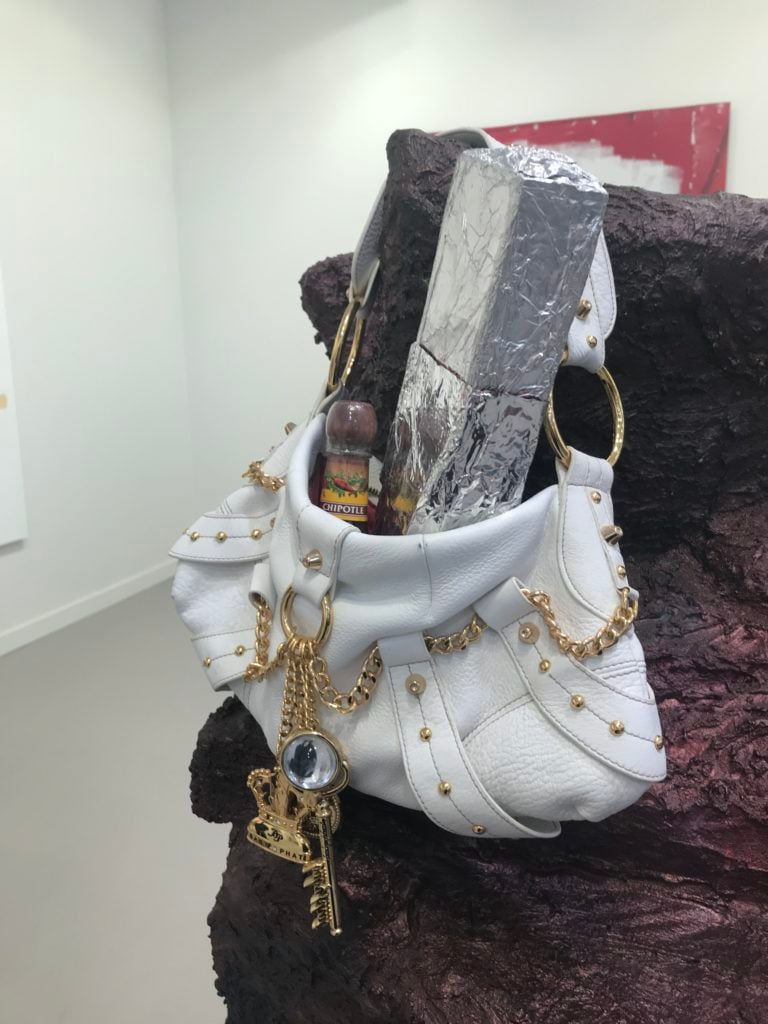
Detali of Rachel Harrison, Sculpture with Hot Sauce, 2018. Photo by Tim Schneider.
On the Paramount lot the day after seeing Beyoncé in the flesh at the opening of UTA Artist Space’s “Dreamweavers” exhibition, I found it impossible to look at the work without hearing Bey half-coo, half-threaten, “I got hot sauce in my bag” on her world-conquering 2016 hit “Formation.” Asked if it was a direct invocation, the gallery’s Jeffrey Rowledge replied that Harrison, no stranger to pop culture references, “hasn’t said so explicitly, but I think that’s a fair read.” The piece was placed on hold earlier in the day at an asking price of $250,000. The gallery hoped to finalize the sale by day’s end. But as with the lasting effect of Frieze Los Angeles on the city’s identity in the public consciousness, the rest of that story has yet to be written at this hour.
Frieze Los Angeles is on view at Paramount Pictures Studios, 5515 Melrose Ave, Los Angeles, California, February 14–17, 2019.